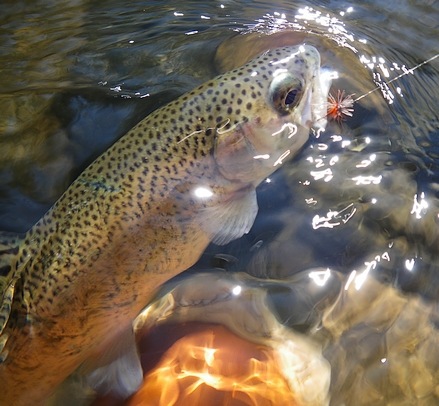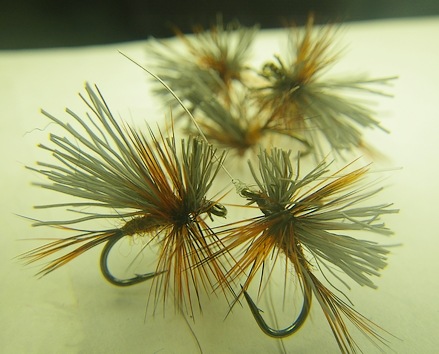Nope, there’s no gaudy beads or feelers, no articulated body parts or rare materials to keep you from owning these killers immediately …
… although there is that trust thing …
Nor will I mention the hair extensions you’ll have to tear out by the roots, or the groans of the feminine members of the household as they watch fashion disappear into the firm grip of your hackle pliers …
Yes, the Boys of Summer – the top killing flies of my recent trip – were all dries.

Most of the fish killing was the result of my earlier experimental the “Hovering Predator.” Little surprise given that it has the mayfly upwing when dry, the downwing of a caddis when wet, and as much deer or elk as a full dress Humpy or Elk Hair Caddis.
The fish above gave it about a microsecond before inhaling the beast deeply.

These are so much quicker to tie than a Humpy, and uses only about three turns of hackle per fly, relying instead on all those trimmed deer hair butts to give it a high floating three point stance. I doll it up with floatant to preserve the mayfly silhouette in slow water – and fling it without regard for dampness in the faster currents.

Second best was the time honored Yellow Sally I was introduced to at Hat Creek. Bright yellow body and scarlet egg sac, natural elk tips and ginger hackle complete the fly.
The Little Yellow Stone is a summer constant in the Sierra’s – and anything yellowish is sucked down with great glee by fish used to seeing it flutter by. In low light and with old eyes, it’s a welcome spot of white that can be seen immediately, and makes us geezers on equal footing with the younger crowd.
I tied all my dry flies on the fancy barbless tournament steel for the last two years. Not so much a preference as it is research in progress, a future article that may aid you in calculating their value to the casual angler.

“Yes, the Boys of Summer – the top killing flies of my recent trip – were all dries.”
I once had a year like that, but on a whim I only fished dries the entire season.
Did you fish subsurface at all?
Have you tied/tried the HP with the tips aligned instead of clipped?
OOPs, nevermind. I missed the HP post about using scraps.
I’ve tried it both ways and my feeling was there’s much more floatation on the clipped fibers than the tips. Just look at the diameter of the fibers – tip versus butt, that has to reflect on the floatation qualities.
All theoretical naturally, but it has the ring of sound science …
Hmmm…Veddy interesting…
Gonna have to tie up some of them H.P.’s in a quill body/adams variation for my beloved cutthroat here in Ideeho. Wonder how they would do as a #20 blue winged olive? Will report back.
I’ll have to whip out the vise tonight! Thanks for the patterns.
Keith, you wrote:
“relying instead on all those trimmed deer hair butts to give it a high floating three point stance.”
I can’t get a mental picture of how the fly is supposed to float. Care to elaborate?
There’s much less hackle on the fly compared to a traditional high floating dry. By using a large clump of deer hair butts fanned across the top of the hook (and over the eye)- it augments the hackle and ensures the fly lands with fibers of the wing in the water as well as everything else.
When dry those fibers are flared upwards and give a mayfly silouette, as they become saturated, they sag and give a caddis silouette.
Depending on the mix of real bugs on the water, you may want to fish it soaked or bone dry.
Without waxing the hair to keep it upright (and repelling water) the fibers will tend to flare out when bound onto the shank and will stabilize the ride – actually touching the water like outriggers. This gives you a stable profile and allows it to ride wing up – versus flopping onto its side.